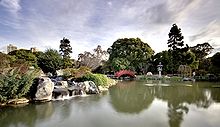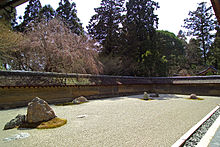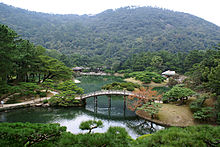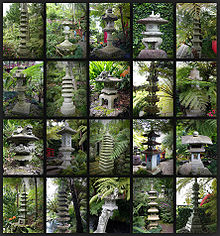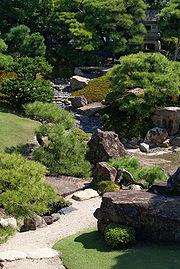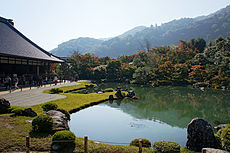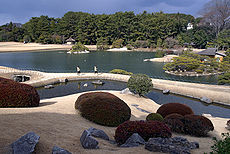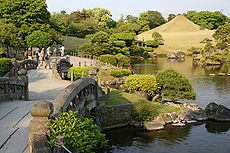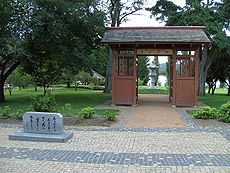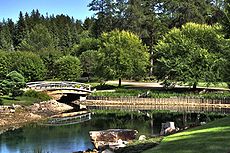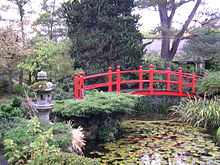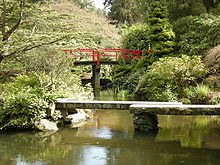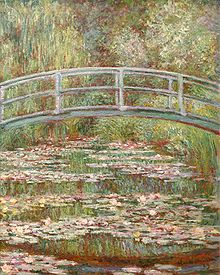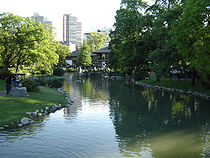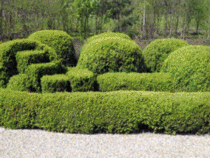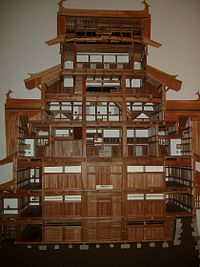- Japanese garden
-
Japanese gardens (日本庭園 nihon teien), that is, gardens in traditional Japanese style, can be found at private homes, in neighborhood or city parks, and at historical landmarks such as Buddhist temples, Shinto shrines and old castles.
Landscape gardener Seyemon Kusumoto wrote that the Japanese generate "the best of nature's handiwork in a limited space."[1] Some of the Japanese gardens most famous in the West, and within Japan as well, are dry gardens or rock gardens, karesansui. The tradition of the Tea masters has produced highly refined Japanese gardens of quite another style, evoking rural simplicity. In Japanese culture, garden-making is a high art, intimately related to the linked arts of calligraphy and ink painting. Since the end of the 19th century, Japanese gardens have also been adapted to Western settings.
Japanese gardens were developed under the influences of the distinctive and stylized Chinese gardens.[2] One of the great interest for the historical development of the Japanese garden, bonseki, bonsai and related arts is the c. 1300 Zen monk Kokan Shiren and his rhymeprose essay Rhymeprose on a Miniature Landscape Garden.
The tradition of Japanese gardening was historically passed down from sensei to apprentice. In recent decades this has been supplemented by various trade schools. However, the opening words of Zōen's Illustrations for designing mountain, water and hillside field landscapes (1466) are "If you have not received the oral transmissions, you must not make gardens" and its closing admonition is "You must never show this writing to outsiders. You must keep it secret".[3]
 This view from the Symbolic Mountain in the gardens in Cowra, Australia shows many of the typical elements of a Japanese garden.
This view from the Symbolic Mountain in the gardens in Cowra, Australia shows many of the typical elements of a Japanese garden.
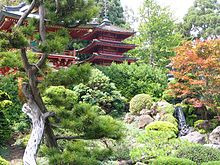 Hagiwara Japanese Tea Garden in San Francisco, California, showing the use of stone, water and plants
Hagiwara Japanese Tea Garden in San Francisco, California, showing the use of stone, water and plants
Contents
Typical features
A catalogue of features "typical" of the Japanese garden may be drawn up without inquiring deeply into the aesthetic underlying Japanese practice. Typical Japanese gardens have at their center a home from which the garden is viewed. In addition to residential architecture, depending on the archetype, Japanese gardens often contain several of these elements:
- Water, real or symbolic.
- A bridge over the water, or stepping stones.
- Rocks or stone arrangements (or settings).
- A lantern, typically of stone.
- A teahouse or pavilion.
- An enclosure device such as a hedge, fence, or wall of traditional character.
Styles
Traditional styles:
Karesansui gardens
Karesansui gardens (枯山水) or "dry landscape” gardens were influenced mainly by Zen Buddhism and can be found at Zen temples of meditation (Japan Guide). Unlike other traditional gardens, there is no water present in Karesansui gardens. However, there is raked gravel or sand that simulates the feeling of water. The rocks or gravel used are chosen for their artistic shapes, and mosses as well as small shrubs are used to further garnish the Karesansui style (Japanese Lifestyle). All in all, the rocks and moss are used to represent ponds, islands, boats, seas, rivers, and mountains in an abstract way (Japan Guide). - Example: Ryōan-ji, temple in Kyoto, has a garden famous for representing this style. Daisen-in, created in 1513, is also particularly renowned.
Tsukiyama Gardens
Tsukiyama Gardens often copy famous landscapes from China or Japan, and they commonly strive to make a smaller garden appear more spacious (Japan Guide). This is accomplished by utilizing shrubs to block views of surrounding buildings, and the garden's structure usually tries to make onlookers focus on nearby mountains in the distance (Japanese Lifestyle). By doing this, it seems that the garden has the mountains as part of its grounds. Ponds, streams, hills, stones, trees, flowers, bridges, and paths are also used frequently in this style (Japan Guide).
Chaniwa Gardens
Chaniwa Gardens are built for holding tea ceremonies. There is usually a tea house where the ceremonies occur, and the styles of both the hut and garden are based on the simple concepts of the sado (Japan Guide). Usually, there are stepping stones leading to the tea house, stone lantern, and stone basins (tsukubai) where guests purify themselves before a ceremony(Japan Guide).
Japanese gardens might also fall into one of these styles:
- Kanshoh-style gardens which are viewed from a residence.
- Pond gardens, for viewing from a boat.
- Strolling gardens (kaiyū-shiki), for viewing a sequence of effects from a path which circumnavigates the garden. The 17th-century Katsura garden in Kyoto is a famous exemplar.
Other gardens also use similar rocks for decoration, some of which come from distant parts of Japan. In addition, bamboos and related plants, evergreens including Japanese black pine, and such deciduous trees as maples grow above a carpet of ferns and mosses.
Use of stones, water, and plantings
Though often thought of as tranquil sanctuaries that allow individuals to escape from the stresses of daily life, Japanese gardens are designed for a variety of purposes. Some gardens invite quiet contemplation, but may have also been intended for recreation, the display of rare plant specimens, or the exhibition of unusual rocks.
Kaiyu-shiki or Strolling Gardens require the observer to walk through the garden to fully appreciate it. A premeditated path takes observers through each unique area of a Japanese garden. Uneven surfaces are placed in specific spaces to prompt people to look down at particular points. When the observer looks up, they will see an eye-catching ornamentation which is intended to enlighten and revive the spirit of the observer. This type of design is known as the Japanese landscape principle of "hide and reveal".
Stones are used to construct the garden's paths, bridges, and walkways. Stones can also represent a geological presence where actual mountains are not viewable or present. They are sometimes placed in odd numbers and a majority of the groupings reflect triangular shapes, which often are the mountains of China.
A water source in a Japanese garden should appear to be part of the natural surroundings; this is why one will not find fountains in traditional gardens. Man-made streams are built with curves and irregularities to create a serene and natural appearance. Lanterns are often placed beside some of the most prominent water basins (either a pond or a stream) in a garden. In some gardens one will find a dry pond or stream. Dry ponds and streams have as much impact as do the ones filled with water.
Green plants are another element of Japanese gardens. Japanese traditions prefer subtle green tones, but flowering trees and shrubs are also used. Many plants in imitated Japanese gardens of the West are indigenous to Japan, though some sacrifices must be made to account for the differentiating climates. Some plants, such as sugar maple and firebush, give the garden a broader palette of seasonal color.
Overview of Japanese garden history
During the Asuka period (538–710), gardens were supposed to express Buddhism and Taoism through replicating the mountainous regions in China (Japanese Lifestyle). Ruins of these types of gardens can be found in Fujiwara and Heijyo castle towns (Japanese Lifestyle).
During the Nara period (710-94), Shinto worshippers encountered the gardens of the capital in China and these gardens were carefully recreated near the palace.[4] During the Heian period (794-1185), gardens shifted from solely representing religious beliefs to becoming, "a place for ceremonies, amusement, and contemplation" (Miller). Gardens began to surround mansions that had the shinden-zukuri style (Japanese Lifestyle). In this style, the garden was located at the front of a building, also known as the south side (Japanese Lifestyle). As part of the garden style, there was water flowing through artificial passages that eventually spilled into ponds with little islands in them (Japanese Lifestyle). Very few of these gardens have survived to this day, and thus, are certainly a rarity in modern history. Despite the lack of modern day examples, we have the book of Sakuteiki that describes how people of this era formulated this garden style movement (Japanese Lifestyle). Later in this period, pure-land-style gardens became popular through the Pure Land Buddhism influence, and these gardens imitated the Paradise in the Western Pureland as a result (Japanese Lifestyle). During this shift in style, the Japanese also began to model their gardens and homes after the Amitabha hall style instead of the shinden style (Japanese Lifestyle). Examples of the Amitabha style can be seen today in Mahayana Hall (Nara), Byodoin (Uji, Kyoto), the Jyoruri Temple, and Motsuji Temple (Hiraizumi, Nishi, Iwai, Iwate) (Japanese Lifestyle).
In the Kamakura and Muromachi periods (1185-1573), a great many gardens were created during these two time periods due to improved garden techniques and the development of Syoinzukuri style (Japanese Lifestyle). Zen beliefs were also flourishing at this time and had great influences over garden techniques and purposes. Another factor that allowed gardens to flourish stems from the fact that the shoguns simply enjoyed gardens. Dry landscape style also emerged during this time (Japanese Lifestyle). A notable gardener who appeared during these periods is Soseki Muso: He made Saihoji Temple (Kyoto), Tenruji Temple (Kyoto), and Zuizenji Temple (Kamakura) gardens. (Japanese Lifestyle)
After the Muromachi Period, Japanese tea ceremonies became an intricate part of Japanese culture (Japanese Lifestyle). Sen no Rikyu (1517-1591) created the traditional style of a tea house where there was usually a roji (“dewy path”) leading to the house (Japanese Lifestyle). Besides the tea houses, gardens constructed in the Edo period (1603-1868) reflected the tastes and style of each individual shogun ruler. Instead of being a religious symbol, gardens shifted to being a symbol of a shogun’s prestige and power (Miller). These tea house styled houses and gardens can be seen in Kenrokuen (Kanazawa), Kōraku-en (Okayama), Ritsurin Garden (Takamsatsu), Koishikawa Korakuen (Tokyo), and Suizenji Park (Kumamoto) (Japanese Lifestyle).
In the Meiji period following the modernization of Japan, famous traditional gardens were owned by businessmen and politicians. Some of these extensive gardens are open to public viewing in Murinan (Kyoto) and Chinzanso (Tokyo) (Japanese Lifestyle). Famous gardeners of this period include 7th generation Jihe Ogawa, known as Ueji, and innovative dry landscape garden designer Mirei Shigemori. (Japanese Lifestyle)
Cultural Aspects of Japanese Gardens
Poetry
Many poems were inspired and written about the different Japanese Gardens. An example of the poems written includes:
- Chiimei’s haiku about a tea ceremony hut and garden: “I laid a foundation and roughly thatched roof. I fastened hinges to the joints of the beams, the easier to move elsewhere should anything displease me. . . . Since first I hid my traces here in the heart of Mount Hino, I have added a lean-to on the south and a porch of bamboo. On the west I have built a shelf for holy water, and inside the hut, along the west wall, I have installed an image of Amida. . . . Above the sliding door that faces north I have built a little shelf on which I keep three or four black leather baskets that contain books of poetry and music and extracts from the sacred writings. Beside them stand a folding iioto and a lute. Along the east wall I have spread long fern fronds and mats of straw, which serve as my bed for the night. I have cut open a window in the eastern wall, and beneath it have made a desk. Near my pillow is a square brazier in which I burn brushwood. To the north of the hut I have staked out a small plot of land that I have enclosed with a rough fence and made into a garden. I grow many species of herbs there.” (Varley pg. 93)
Literature
- The Tale of Genji describes the “shinden-zukun” style garden of the Heian Period.
- During the Heian Period the “Sakuteiki” was written- the first book to discuss allotment of land, stone arrangements, artificial waterfalls, water passages, and planting.
Tea Ceremonies
After the tea ceremony was refined by Sen Rikyu, the tea garden, house, and utensils all served as a way to “awaken consciousness and to realize with humility our relationship with all that is around us and with the universe itself(Miller).” Also, tea ceremonies were partly designed to teach participants how to gain absolute control over body and mind (Kato p. 27). As a result, "it emphasizes not disconnection but connection between body movement and mind (Kato p. 27)." Culturally, the Japanese followed the five Confucian virtues (loyalty, righteousness, politeness, wisdom, and trust) to ground these tea ceremony ideals off of (Kato p. 27). In short, the tea ceremonies were a cultural activity to teach Japanese/Confucian virtues that were important for life.
Noteworthy Japanese gardens
In Japan
The Minister of Education, Culture, Sports, Science and Technology of the government of Japan designates the most notable of the nation's scenic beauty as Special Places of Scenic Beauty, under the Law for the Protection of Cultural Properties.[5] As of March 1, 2007, 29 sites are listed, more than a half of which are Japanese gardens, as below;
Boldface entries specify World Heritage Sites.
- Tohoku Region
- Mōtsū-ji Garden (Hiraizumi, Iwate)
- Kantō region
- Chūbu region
- Kenroku-en (Kanazawa, Ishikawa)
- Ichijōdani Asakura Family Gardens (Fukui, Fukui)
- Kansai Region
- Byodo-In Garden (Uji, Kyoto)
- Jisho-ji Garden (Kyoto, Kyoto)
- Nijō Castle Ninomaru Garden (Kyoto, Kyoto)
- Rokuon-ji Garden (Kyoto, Kyoto)
- Ryōan-ji Garden (Kyoto, Kyoto)
- Tenryu-ji Garden (Kyoto, Kyoto)
- The garden of Sanbōin in Daigo-ji (Kyoto, Kyoto)
- The moss garden of Saihō-ji (the "Moss Temple") (Kyoto, Kyoto)
- Daitoku-ji Garden (Kyoto, Kyoto)
- The garden of Daisen-in in Daitoku-ji (Kyoto, Kyoto)
-
- Negoro-ji Garden (Iwade, Wakayama)
- Chūgoku region
- Adachi Museum of Art Garden (Yasugi, Shimane)
- Kōraku-en (Okayama, Okayama)
- Matsue Vogel Park (Matsue)
- Shuraku-en, (Tsuyama)
- Shikoku Region
- Ritsurin Garden (Takamatsu, Kagawa)
- Nakatsu Banshoen (Marugame, Kagawa)
- Tensha-en (Uwajima, Ehime)
- Kyushu Region
- Suizenji Joju-en (Kumamoto, Kumamoto)
- Sengoku-en (Kagoshima, Kagoshima)
- Ryūkyū Islands
- Shikina-en (Naha, Okinawa)
However, the Education Minister is not eligible to have jurisdiction over any imperial property. These two gardens, administered by Imperial Household Agency, are also considered to be great masterpieces.
- Katsura Imperial Villa[6]
- Shugaku-in Imperial Villa[7]
In the English-speaking world
The aesthetic of Japanese gardens was introduced to the English-speaking community by Josiah Conder's Landscape Gardening in Japan (Kelly & Walsh, 1893). It sparked the first Japanese gardens in the West. A second edition was required in 1912.[8] Conder's principles have sometimes proved hard to follow:
- "Robbed of its local garb and mannerisms, the Japanese method reveals aesthetic principles applicable to the gardens of any country, teaching, as it does, how to convert into a poem or picture a composition, which, with all its variety of detail, otherwise lacks unity and intent"[9]
Samuel Newsom's Japanese Garden Construction (1939) offered Japanese aesthetic as a corrective in the construction of rock gardens, which owed their quite separate origins in the West to the mid-19th century desire to grow alpines in an approximation of Alpine scree.
According to the Garden History Society, Japanese landscape gardener Seyemon Kusumoto was involved in the development of around 200 gardens in the UK. In 1937 he exhibited a rock garden at the Chelsea Flower Show, and worked on the Burngreave Estate at Bognor Regis, and also on a Japanese garden at Cottered in Hertfordshire. The lush courtyards at Du Cane Court—an art deco block of flats in Balham, London, built between 1935 and 1938—were designed by Kusumoto. All four courtyards there may have originally contained ponds. Only one survives, and this is stocked with koi. There are also several stone lanterns, which are meant to symbolise the illumination of one's path through life; similarly, the paths through the gardens are not straight. Japanese maple, Japanese anemone, cherry trees, evergreens, and bamboo are other typical features of Du Cane Court's gardens.[1]
Australia
- Canberra Nara Park
- Cowra Japanese Garden, Cowra, New South Wales
- Frankston High School
- Himeji Gardens, Adelaide
- Melbourne Zoo
- "Tsuki-yama-chisen" Japanese Garden, Brisbane
- Nerima Gardens, Ipswich
- Toowomba Japanese Garden, Ju Raku En, Queensland
New Zealand
Canada
- Nitobe Memorial Garden, Vancouver, British Columbia
- The Devonian Botanical Garden, Edmonton, Alberta, which contains an extensive Japanese garden
- Nikka Yuko Japanese Garden, Lethbridge, Alberta [1]
- The Japanese Garden and Pavilion, Montreal Botanical Garden, Quebec
- Kariya Park, Mississauga, Ontario [2]
United Kingdom
- England
- Ame (rain) Japanese style private garden near Bolton in Lancashire England - an on-going project
- Compton Acres, Dorset[10]
- Dartington Hall, Devon[11]
- Harewood House, Leeds
- Holland Park, London[11]
- St Mawgan in Pydar, Cornwall[12]
- Tatton Park, Cheshire[11]
- School of Oriental and African Studies, London[11]
- Northern Ireland
- Scotland
- Lauriston Castle, Edinburgh—garden opened 2002[11]
Ireland
- The Japanese Gardens at the Irish National Stud, Kildare, Co. Kildare[11]
- Fujiyama Japanese Garden (Northern Ireland)
Japanese Garden, Tully, County Kildare. Red lacquered arched bridges are Chinese in origin and seldom seen in Japan, but are often placed in Japanese-style gardens in other countries.[13]
Singapore
- Japanese Garden - a garden island located in Jurong Lake
United States of America
- Anderson Japanese Gardens (Rockford, Illinois)
- Birmingham Botanical Gardens (Birmingham, Alabama)
- Brooklyn Botanic Garden (Brooklyn, New York)
- Chicago Botanic Garden (Glencoe, Illinois)
- Earl Burns Miller Japanese Garden (California State University, Long Beach)
- Fort Worth Japanese Garden at the Fort Worth Botanic Garden (Fort Worth, Texas)
- Hagiwara Japanese Tea Garden (San Francisco, California)
- Hakone Gardens (Saratoga, California)
- Hayward Japanese Gardens (Hayward, California), the oldest traditionally designed Japanese garden in California.[14]
- The Huntington (San Marino, California)
- Japanese Friendship Garden (Phoenix, Arizona)
- Japanese Friendship Garden (Kelley Park) (San Jose, California)
- Japanese Garden at Marjorie McNeely Conservatory (St Paul, Minnesota)
- Japanese garden at Minnesota Landscape Arboretum (near Chanhassen, Minnesota)
- Kumamoto En (San Antonio, Texas)
- Morikami Museum and Japanese Gardens, Delray Beach, Florida
- Normandale Japanese Garden (Bloomington, Minnesota)
- Portland Japanese Garden (Portland, Oregon)
- Seattle Japanese Garden at the Washington Park Arboretum, Kubota Garden (Seattle, Washington)
- The Japanese Garden (Los Angeles, California)
- Seiwa-en at the Missouri Botanical Garden (St. Louis, Missouri)
- Taniguchi Japanese Garden (Austin, Texas)
- Yuko-En on the Elkhorn (Georgetown, Kentucky)
- Shigematsu Memorial Japanese Garden at Lansing Community College, Lansing, Michigan
In other countries
- Argentina: The Buenos Aires Japanese Gardens (Jardín Japonés de Buenos Aires), of the Fundación Cultural Argentino Japonesa [3]
- Belgium: Japanse tuin (http://nl.wikipedia.org/wiki/Japanse_Tuin_(Hasselt) ), Hasselt
- Brazil
- Parque Santos Dummont, São José dos Campos, São Paulo
- Bosque Municipal Fábio Barreto, Ribeirão Preto, São Paulo
- Chile: La Serena, Chile
- France: Jardin japonais du Musée départemental Albert-Kahn, Boulogne-Billancourt
- Germany: Hamburg, Leverkusen, Kaiserslautern, Munich (in the Englischer Garten).
- Mongolia: Juulchin street cnr Jigjidjav street, Ulaanbaatar, established in 2005 by a Mongolian sumo wrestler
- The Netherlands:
- The Japanse Tuin of Clingendael park
- The Tsubo-en karesansui garden in Lelystad is a private Modern Japanese Zen (karesansui, dry rock) garden in The Netherlands. All details including the realization are documented on the website www.zen-garden.org
- Poland: The Japanese Garden in Wrocław - founded 1913, restored 1996-1997, destroyed by flood, restored 1999
- Russia: The Japanese Garden in Moscow — founded 1983, opened 1987 (landscape architect Ken Nakajima).
- Serbia: The Japanese Garden in Botanical Garden Jevremovac - opened 2004 (landscape architects Vera and Mihailo Grbic).
- Sweden: Japanska Trädgården in Ronneby Brunnspark, Blekinge.
See also
References
- ^ a b Vincent, Gregory K. (2008). A history of Du Cane Court : land, architecture, people and politics. Woodbine. ISBN 0954167511.
- ^ Encyclopædia Britannica. Garden and landscape design: Japanese. Accessed: 7 March 2008.
- ^ The Illustrations, nevertheless, are translated and annotated in David A. Slawson, Secret Teachings in the Art of Japanese Gardens (New York/Tokyo: Kodansha 1987), which forms in effect an introduction to the text.
- ^ Hoover, Thomas (1978). "Chapter seven: Zen and the landscape garden". Zen culture. New York: Vintage Books. ISBN 9780394725208. http://books.google.com/books?id=214PatxcJVcC.
- ^ MEXT : Ministry of Education, Culture, Sports, Science and Technology
- ^ JNTO Website | Find a Location | Kyoto | Katsura
- ^ JNTO Website | Find a Location | Kyoto | Shugaku-in Imperial Villa
- ^ Slawson 1987:15 and note2.
- ^ Conder quoted in Slawson 1987:15.
- ^ "Japanese Gardens in the UK and Ireland — Compton Acres". http://japan-interface.co.uk/gardens/details.php?garID=47. Retrieved 2007-12-11.
- ^ a b c d e f "UK and Ireland Survey". Japanese Garden Journal 35. September/October 2003. http://www.rothteien.com/topics/uk-survey.htm. Retrieved 2007-12-11.
- ^ http://www.buildajapanesegarden.com Japanese Gardens and Nursery]
- ^ Eliovson, Sima (1971). Gardening the Japanese way. Harrap. pp. 47. ISBN 9780245506949. "Red lacquered arched bridges are seldom seen in Japan, although they are often placed in Japanese-styled gardens in other countries. These are of Chinese origin and there are only a few in evidence in Japanese gardens."
- ^ The Japanese Gardens. Dmtonline.org. Retrieved on 2010-12-25.
- Slawson, David A. Secret Teachings in the Art of Japanese Gardens (New York/Tokyo: Kodansha 1987)
- Yagi, Koji A Japanese Touch for Your Home (Kodansha 1982)
- Miller, P. (2005), The Japanese Garden: Gateway to the Human Spirit, International Journal of Humanities & Peace 2005, Vol. 21 Issue 1, Retrieved August 3, 2008 from: http://researchport.umd.edu
- Kato, E. (2004), The Tea Ceremony and Women’s Empowerment in Modern Japan, RoutledgeCurzon, Retrieved August 3, 2008 from: http://www.netlibrary.com.ezproxy.umuc.edu/Reader/
- Varely, P. (2000), Japanese Culture Fourth Edition, The Maple – Vaile Book Manufacturing Group, Retrieved August 3, 2008 from: http://www.netlibrary.com.ezproxy.umuc.edu/Reader/
- Japan Lifestyles. (2008), Japanese Garden History, GNU Free Documentation License, Retrieved August 2, 2008 from: http://www.japaneselifestyle.com.au/
- Gardens, Japan Guide (1996-2008), Retrieved August 3, 2008 from: http://www.japan-guide.com/
External links
- Japanese Gardens 65+ in Japan, others overseas
- Japanese Gardens, Bowdoin College
Elements of Japanese architecture Styles Buddhist · Buke · Daibutsuyō · Gassho · Giyōfū · Hachiman · Hirairi · Hiyoshi (also called Hie) · Irimoya · Ishi-no-ma · Kasuga · Kibitsu · Nagare · Ōbaku Zen · Setchūyō · Shinden · Shinmei · Shinto · Shoin · Sukiya · Sumiyoshi · Taisha · Wayō · ZenshūyōBuilding types Roof styles Structural Burdock piling · Chigi · Disordered piling · Engawa · Fusuma · Hisashi · Irimoya-zukuri · Irori · Jinmaku · Katōmado · Katsuogi · Kuruwa · Mokoshi · Moya · Nakazonae · Namako wall · Nightingale floor · Onigawara · Ranma · Shōji (see also washi) · Sōrin · Tamagaki · Tatami · Tokonoma · Tokyō · Tsumairi · ShibiGates and approaches Rooms Furnishings Outdoor objects Measurements Groups See also Categories:- Japanese gardens
- Landscape design history of Japan
- Japanese style of gardening
- Types of garden
- Landscape design history
Wikimedia Foundation. 2010.

